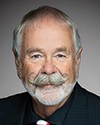When it comes to bees.... To take a step back from there, if you look at a hive, bees tend to start to fly and really start to forage once it hits a temperature of about 10°C, and there's sunlight. That's when the foragers want to leave. They want to go out and fly. They're quite oblivious to the fact that they're put on the back of a truck. All they know is that there's sunshine outside, that it's warm enough, and they want to go and see if they can find something to eat. That's the cognitive depth of thought when they're there.
When you're driving down the road, you do lose a number of bees because they want to go out and forage. The hotter it gets, the more likely they are to try to leave the hive. The hive is kind of like a living organism. It wants to be at 36°C. The closer you get to 36°C, the more ventilation they need and the more distributed they'll become inside the hive. They'll break cluster, and the foragers will want to get out and leave. That causes some problems. We do not like to move bees when it's that hot. If we do, then we try to do it at night.
We do everything we can to avoid moving bees during the daylight, simply because we know bees like to fly. They're stimulated by the light. The warmer it is, the more active they become.



